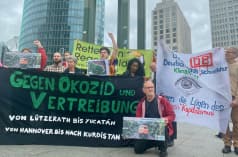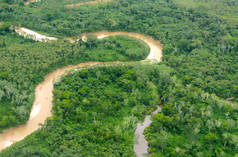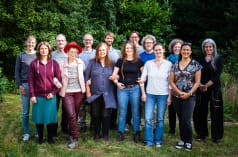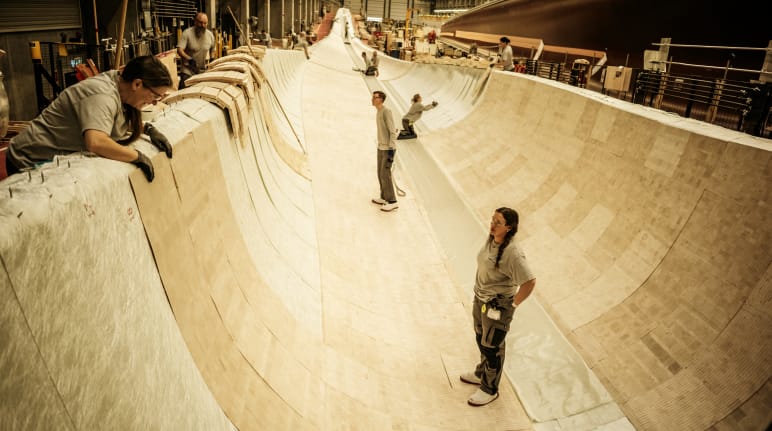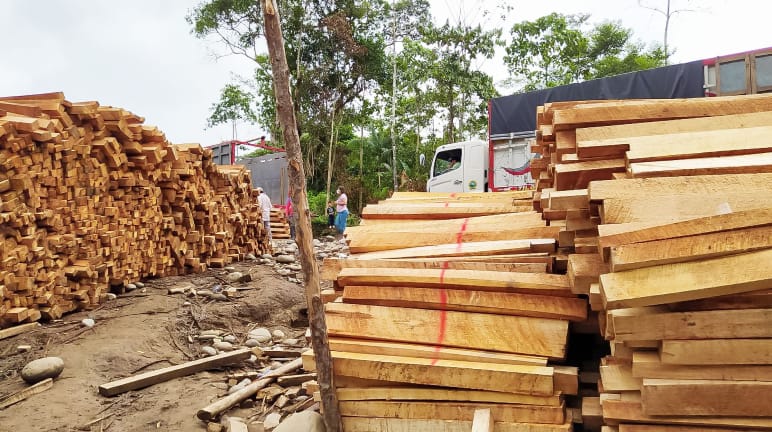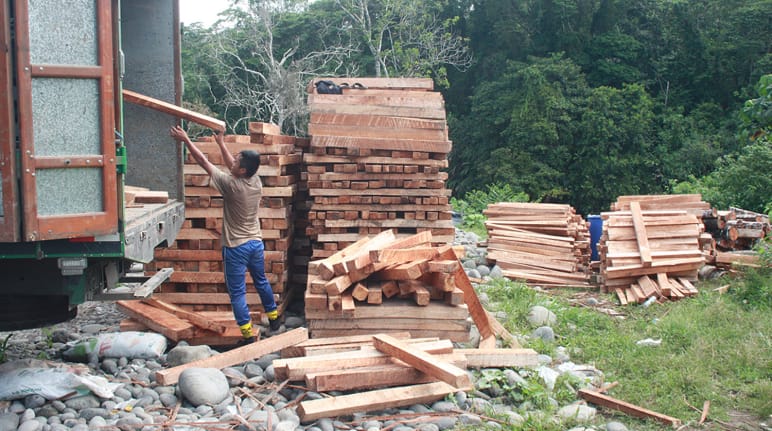Don’t plunder the rainforest for wind energy!
There is no doubt that we need to move to renewable energy as soon as possible – and above all, to dramatically reduce our energy and resource consumption. Wind turbines are a key part of that transition, but their rotors often contain large quantities of tropical balsa wood. Rainforests in Ecuador are being plundered for balsa.
Call to actionTo: Siemens Gamesa, General Electric, LM Wind Power, Vestas, Nordex, Enercon
“The wind power industry must ensure transparency in its balsa wood supply chain and not use balsa from rainforest logging.”
The expansion of wind power in China, Europe and North America has triggered a run on balsa wood in Ecuador. Up to 90% of the balsa traded worldwide comes from the South American country.
With existing plantations overwhelmed by the new demand, timber mafias are illegally cutting down balsa trees growing on islands and riverbanks of the Amazon. The loggers invade protected areas and indigenous territories, where they are causing serious social conflict.
The felling of balsa is devastating for local ecosystems. The tree fulfills important ecological functions and protects riverbanks from erosion.
The world’s largest consumer of balsa is Siemens Gamesa. The German-Spanish wind power company used almost 26,000 tons of balsa in 2021 (the equivalent of around 170,000 m³).
The three 81-meter rotor blades of a Siemens Gamesa offshore wind turbine, for example, contain a total of nearly six tons balsa (approx. 40 m³), or the equivalent of 40 trees. The wood is bonded in the blades together with plastics such as PET and PVC, as well as glass fiber and epoxy resins.
Other wind turbine manufacturers also use balsa, but in smaller quantities: In 2021, the figures were approximately 9,000 m³ for Nordex and 2,500 m³ for Vestas.
LM Wind Power, a subsidiary of US multinational General Electric, uses balsa in five percent of its rotors. Neither General Electric, nor the German company Enercon responded to Rainforest Rescue’s inquiries.
The companies state that they uses balsa from 3A Composites, a company based in Switzerland that is the world’s only operator of FSC-certified balsa plantations. However, global balsa consumption by the wind power industry is much higher than the quantities produced by 3A Composites. In particular, the information provided by Siemens Gamesa raises serious doubts.
Balsa supply chains must be made transparent and verifiable.
BackgroundSwiss-based 3A Composites, the world’s only supplier of FSC-certified balsa wood products, says it has produced just over 120,000 m³ of raw balsa lumber at the plantations of its subsidiary Plantabal SA in Ecuador in each of the years from 2019 to 2021. The company does not specify how many cubic meters of finished balsa products were made and delivered. In addition to the wind power industry, 3A Composites also supplies balsa products to the construction industry, as well as to the automotive, railroad, aviation and shipbuilding sectors.
The Ecuadorian Central Bank puts the South American country’s balsa exports in 2019 at a total of 33,000 tons (the equivalent of about 220,000 m³). In 2020, it was almost 75,000 tons (about 500,000 m³) and in 2021, just over 22,000 tons (about 150,000 m³)ii.
In 2019, Siemens Gamesa alone consumed 53,052 tons (around 350,000 m³) of balsa according to its sustainability report. In doing so, the Group apparently cannot rule out the possibility of balsa from unsustainable or illegal sources entering the supply chain. The information provided on balsa in the Siemens Gamesa sustainability report is rather vague:
“In general, we can confirm that it is not an endangered resource and that there are no systematic human rights violations. Our goal is to buy balsa that comes from reputable sources in order to combat illegal logging, which is one of the main causes of deforestation.”
In addition, there are statements that are probably intended to justify the consumption of balsa, but are incorrect from practical experience and have no scientific basis:
“Balsa wood is a rapidly renewable resource that can be easily grown without fertilizers or other additional resources. It can therefore be grown sustainably. In its native environment, balsa is a weed tree that has a relatively short life span. Sometimes it self-seeds in inconvenient locations.”
In actual fact, considerable quantities of mineral fertilizers and pesticides are applied to the balsa plantations of 3A Composites’ subsidiary Plantabal SA in Ecuador. According to FSC certification reports, 13,650 liters of glyphosate applied to an area of 5,529 hectares, as well as 507 liters of the product “Verdict” on 504 hectaresiv. The herbicides are used to eliminate all other plant growth on the land. Insecticides and slug poisons are also sprayed on the balsa plantationsv.
The claim that balsa is a “weed tree” is simply false and lacks any scientific basis. Balsa trees play a vital ecological role in tropical rainforests in Latin America: The fast-growing pioneer tree species quickly takes over clearings and open spaces. Balsa trees thus initiate the first phase of natural renewal and permit tree species of later stages to germinate and grow up in their shade. They are thus crucial for the natural regeneration of rainforests.
Further information:
- Badia I Dalmases, F. (2021) in El Pais. How the wind power boom is driving deforestation in the Amazon: https://english.elpais.com/usa/2021-11-26/how-the-wind-power-boom-is-driving-deforestation-in-the-amazon.html
- Badia I Dalmases, F. (2021) in Open Democracy. A green paradox: Deforesting the Amazon for wind energy in the Global North: https://www.opendemocracy.net/en/democraciaabierta/deforesting-the-amazon-for-wind-energy-in-the-global-north-a-green-paradox/
- InSight Crime (2021). Timber Mafias at Ecuador’s Borders Cash in on Balsa Boom: https://insightcrime.org/news/timber-mafias-ecuadors-borders-cash-in-balsa-boom/
- Connectas (2021). De la selva a la China: La fiebre balsera que pagó 22 centavos de dólar por árbol: https://www.connectas.org/especiales/de-la-selva-a-la-china/
- Bravo, E. (ed), Acción Ecológica, (2021). LA BALSA SE VA. ENERGÍAS RENOVABLES, SELVAS VACIADAS. Expansión de la energía eólica en China y la tala de balsa en el Ecuador: https://www.accionecologica.org/wp-content/uploads/LA-BALSA-SE-VA.pdf
- National Geographic (2011). Open All Night: https://www.nationalgeographic.com/magazine/article/panama-ochroma
Sources:
i 3A Composites/Schweiter Technologies, Annual Reports 2019, 2020, 2021 https://www.schweiter.ch/s1a200/investoren/geschaftsberichte-prasentationen.html?L=3
Amount of balsa wood (“green lumber”) produced by Plantabal: 2021: 124,774 m3; 2020: 123;818 m3; 2019: 122,952 m3
ii Banco Central del Ecuador (generated on Apr. 20, 2022). 08. Export. por Producto Pricipal (nivel 4): https://www.bce.fin.ec/index.php/informacioneconomica/sector-externo
iii Siemens-Gamesa (2022). Consolidated Non-Financial Statement 2021, page 73, tab. 34 https://www.siemensgamesa.com/en-int/-/media/siemensgamesa/downloads/en/sustainability/siemens-gamesa-consolidated-non-financial-statement-2021-en.pdf
iv NEPCON/Preferred by Nature (2021). Informe de Certificación de Manejo Forestal de Segunda Auditoría Plantaciones de Balsa S.A. en Los Ríos, Quevedo, Ecuador, page 21, H. Use of pesticides: https://fsc.secure.force.com/servlet/servlet.FileDownload?file=00P4y00001ZSopoEAD
iv NEPCON/Preferred by Nature (Feb. 23, 2021). Informe de Certificación de la Manejo Forestal de auditoría anual Plantaciones de Balsa S.A. en Los Ríos, Quevedo, Ecuador, page 22, J. Use of pesticides: https://fsc.secure.force.com/servlet/servlet.FileDownload?file=00P4y000017sL3IEAU
To: Siemens Gamesa, General Electric, LM Wind Power, Vestas, Nordex, Enercon
Ladies and Gentlemen,
Environmental organizations and indigenous associations in Ecuador have raised the issue that rainforest areas of the South American country are being plundered for balsa trees growing there naturally. The mostly illegal logging causes serious ecological damage and gives rise to conflicts with indigenous communities.
About three-quarters of the balsa wood traded worldwide goes to the wind power industry. But wind turbine manufacturers like yourself largely gloss over the use of balsa in your corporate and sustainability reports. Balsa appears to be an issue for which the industry wants to avoid public scrutiny.
We call you to ensure transparency in your balsa consumption and supply chains and to rule out the use of balsa from illegal sources and from exploitation of rainforest areas and indigenous territories.
Yours faithfully,
- El Pais (2021). How the wind power boom is driving deforestation in the Amazon: https://english.elpais.com/usa/2021-11-26/how-the-wind-power-boom-is-driving-deforestation-in-the-amazon.html
- InSight Crime (2021). Timber Mafias at Ecuador’s Borders Cash in on Balsa Boom: https://insightcrime.org/news/timber-mafias-ecuadors-borders-cash-in-balsa-boom/
- Connectas (2021). De la selva a la China: La fiebre balsera que pagó 22 centavos de dólar por árbol: https://www.connectas.org/especiales/de-la-selva-a-la-china/
- Bravo, E. (ed), Acción Ecológica, (2021). LA BALSA SE VA. ENERGÍAS RENOVABLES, SELVAS VACIADAS. Expansión de la energía eólica en China y la tala de balsa en el Ecuador: https://www.accionecologica.org/wp-content/uploads/LA-BALSA-SE-VA.pdf
- El Pais (2021). Los molinos de viento deforestan el Amazonas: https://elpais.com/planeta-futuro/2021-11-24/los-molinos-de-viento-deforestan-el-amazonas.html
- El Pais (2021). Fiebre, madera de balsa y pandemia en territorio achuar: https://elpais.com/planeta-futuro/2021-02-12/fiebre-madera-de-balsa-y-pandemia-en-territorio-achuar.html
The tree species fulfills important ecological functions- National Geographic (2011). Open All Night: https://www.nationalgeographic.com/magazine/article/panama-ochroma
used almost 26,000 tons of balsa in 2021
In 2019, Siemens Gamesa used no less than 53,052 tons of balsa (approx.. 350,000 m³).
Source: Siemens-Gamesa (2022). Consolidated Non-Financial Statement 2021, page 73, table 34: https://www.siemensgamesa.com/en-int/-/media/siemensgamesa/downloads/en/sustainability/siemens-gamesa-consolidated-non-financial-statement-2021-en.pdf
nearly six tons balsa (approx. 40 m3)
Siemens Gamesa replied to Rainforest Rescue’s written inquiry: Siemens Gamesa “calculates a consumption of around 700 to 1,000 kg of balsa wood per megawatt of wind turbine produced as standard. The exact amount depends on the turbine model. A breakdown of the materials required for an SG 8.0-167 DD offshore wind turbine (81 meters blade length, 8 MW nominal output power) shows, for example, that for the three rotor blades use a total of approx. 5,800 kg of balsa.”
The density of balsa wood typically used in wind turbines averages 150 kg/m3. One ton (1,000 kg) of balsa thus corresponds to approx. 6.67 m3.
This petition is also available in the following languages:
Help us reach 100,000:
